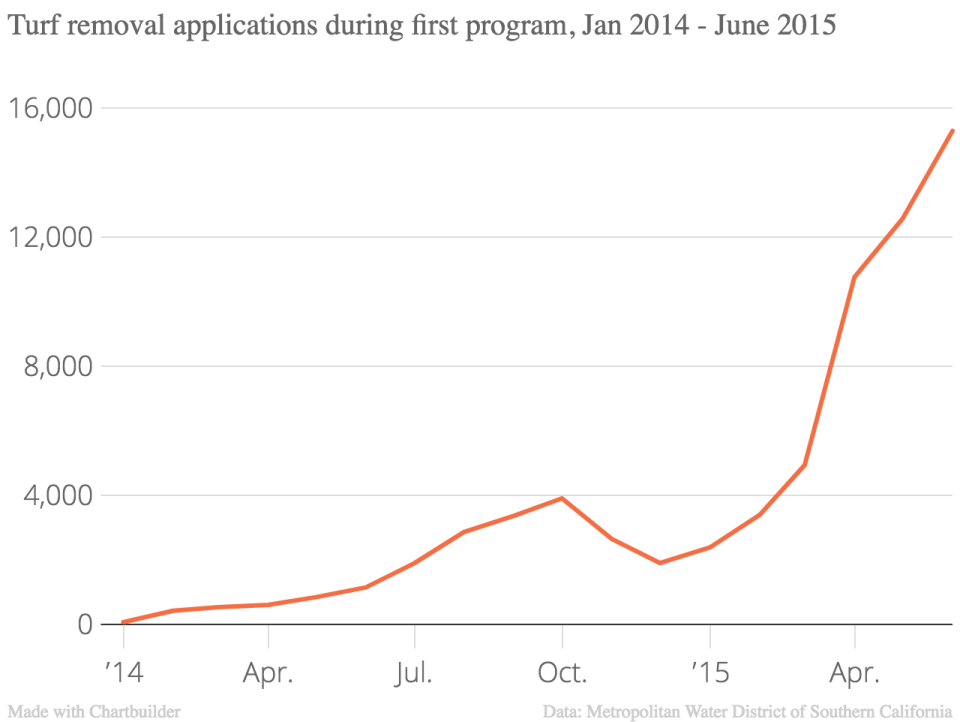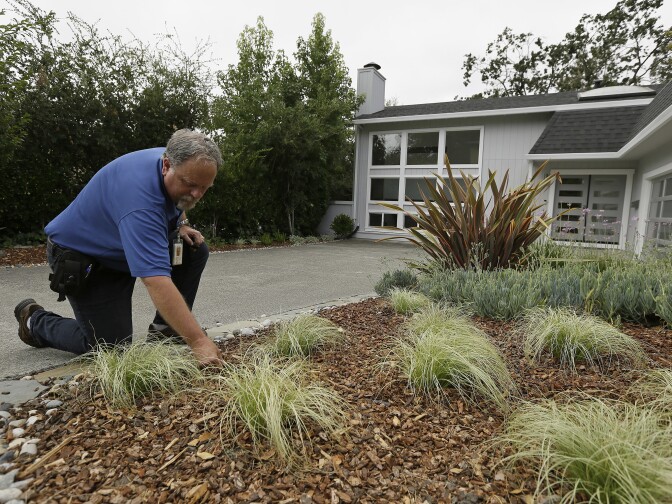Truth matters. Community matters. Your support makes both possible. LAist is one of the few places where news remains independent and free from political and corporate influence. Stand up for truth and for LAist. Make your year-end tax-deductible gift now.
This archival content was originally written for and published on KPCC.org. Keep in mind that links and images may no longer work — and references may be outdated.
Still got a lawn? Here’s another chance to get paid to rip it out
Starting this July, Southern Californians will once again get an extra incentive to rip out their lawns to conserve water. The board of the region’s largest water agency voted Tuesday to spend $43 million a year to bring back its popular “cash for grass” program, which ran during the height of the drought.
But things have changed since the last time, when the Metropolitan Water District didn’t care what you replaced your grass with as long as it saved water. This time around, there are a lot more rules. Here’s what you need to know if you want an MWD rebate to transform your lawn into a California-friendly landscape.
WHO IS ELIGIBLE?
Short answer: pretty much anyone living in Southern California.
Long answer: anyone living in one of the 26 cities and water agencies that buys water from the Metropolitan Water District. Its territory stretches from San Diego to Oxnard and includes some 19 million people. MWD imports water from the Sierra Nevada and the Colorado River and sells it to local utilities, which in turn sell it to you and me. Commercial customers are also eligible.

HOW MUCH MONEY CAN I GET?
One dollar per square foot of grass removed. Depending on where you live, your rebate may be higher because your local water agency may kick in its own rebate. Currently, residents of Los Angeles, Anaheim, Pasadena, Malibu and Topanga Canyon can get additional rebate money. But keep in mind, rebates above $600 are considered taxable income by the IRS.
WHICH LAWN CAN I REPLACE?
Primarily, your front lawn. The idea here is to not only save water, but perhaps inspire your neighbors to do the same.
“For every front yard we give a rebate for, two or three are done by people just driving by and seeing it,” said Bill McDonnell, the head of water efficiency at MWD. “If somebody just re-did the backyard, we would save water. However, no one would see it, so we’d lose that multiplier effect.”
(If you previously ripped out the grass in your front yard, the MWD will still pay you to do your back or side yard. Or if you want to do multiple yards at once, that’s OK too).

WHAT CAN I REPLACE MY GRASS WITH?
Last time, MWD didn’t really care what you replaced your grass with as long as it wasn’t more grass. That resulted in a lot of bare dirt or gravel-only yards, which are not only ugly, they are also ecologically sterile and can raise the ambient air temperature -- a phenomenon known as the "heat island effect."
This time, MWD is being much pickier. In order to get a rebate, you must replace your grass with plants, preferably native and drought tolerant varieties. No bare soil can be showing. Any open spaces must be covered in mulch to keep soils moist between waterings. And you have to install some kind of water capturing system, like a rain barrel or rock garden. You also have to switch to an efficient irrigation system (if you want to read all the rules, go here).

CAN I GET ARTIFICIAL TURF?
No, and here’s why: artificial turf doesn’t provide the same ecosystem benefits as live plants. Butterflies can’t pollenate it. Insects can’t nibble on it. And because it doesn’t perform evapotranspiration, it doesn’t cool the environment. In fact, artificial turf may even raise the temperature.
“Previously, we were trying to get as much water savings as possible, and synthetic turf obviously saves water,” said McDonnell. “Now that we are not in that type of rush mode, we want landscapes that save water, but they’re also California friendly.”
HOW SOON CAN I START TEARING OUT MY GRASS?
The rebates will be available beginning this summer, likely in July.
WILL MWD RUN OUT OF MONEY, LIKE THEY DID LAST TIME?
Last time MWD’s program was so popular, it lasted just 17 months before the board shut it down in July 2015. By then, the agency had paid out $239 million in rebates to more than 46,000 people and ripped out over 100 million square feet of grass – almost 4 square miles.

This time, MWD staff say they intend the grass replacement program to be on-going, similar to their rebates for toilets, washing machines and other high-efficiency appliances. “We’re trying to make the outside of the house as water efficient as the inside,” said McDonnell.
MWD has budgeted up to $50 million each year for turf-removal rebates. When they reach the annual cap, the program will stop taking applications but begin again the following year. The idea is to focus on long-term landscape conversion, rather than short-term, emergency water savings.
This story is part of Elemental: Covering Sustainability, a new multimedia collaboration between Cronkite News, Arizona PBS, KJZZ, KPCC, Rocky Mountain PBS and PBS SoCal.












